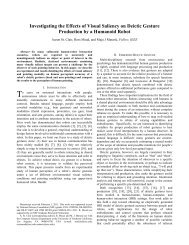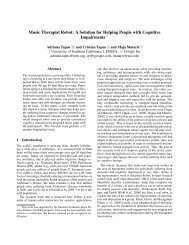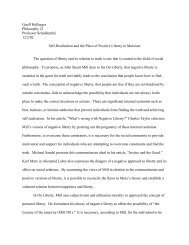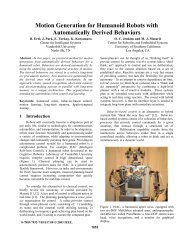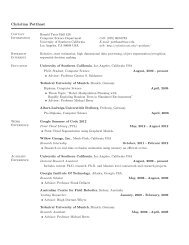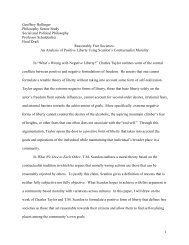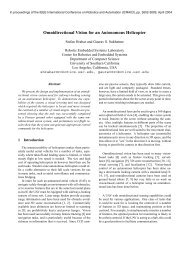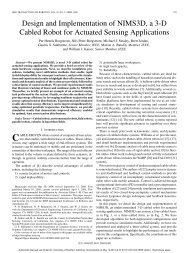A Socially Assistive Robot Exercise Coach for the Elderly
A Socially Assistive Robot Exercise Coach for the Elderly
A Socially Assistive Robot Exercise Coach for the Elderly
Create successful ePaper yourself
Turn your PDF publications into a flip-book with our unique Google optimized e-Paper software.
Fasola & Matarić. A SAR <strong>Exercise</strong> <strong>Coach</strong> <strong>for</strong> <strong>the</strong> <strong>Elderly</strong>conditions over time. Data ga<strong>the</strong>red from <strong>the</strong> first and fourth session post-session surveyswere analyzed using a two-tailed independent two-sample T-test assuming unequalvariances to test <strong>for</strong> significant differences among <strong>the</strong> participant evaluations of <strong>the</strong> robotand <strong>the</strong> interaction across both conditions. Survey results from <strong>the</strong> fourth session wereused to per<strong>for</strong>m <strong>the</strong> final comparison analysis, as <strong>the</strong>y were less likely to contain scoresinfluenced by <strong>the</strong> effect of novelty.4.2 Participant StatisticsWe recruited elderly individuals to participate in <strong>the</strong> study through a partnership withbe.group, an organization of senior living communities in Sou<strong>the</strong>rn Cali<strong>for</strong>nia, usingflyers and word-of-mouth. We offered a $50 Target gift card to those willing toparticipate in all four sessions of <strong>the</strong> study. Thirty-seven people responded, of whom fourwere omitted due to inconsistent/incorrect answers to survey questions that were used toidentify questionable survey results. Thus, <strong>the</strong>re were a total of 33 participants whosedata were analyzed. Half of <strong>the</strong> participants were placed in <strong>the</strong> physical robot group (n =16), and <strong>the</strong> o<strong>the</strong>r half were placed in <strong>the</strong> virtual robot group (n = 17). The samplepopulation consisted of 27 female participants (82%) and 6 male participants (18%).Participants’ ages ranged from 68–88, and <strong>the</strong> average age was 76 (SD = 6.32).4.3 Measures4.3.1 Evaluation of InteractionThere were two dependent measures used to evaluate <strong>the</strong> interaction with <strong>the</strong> robotexercise system. The first measure was <strong>the</strong> enjoyableness of <strong>the</strong> interaction, collectedfrom participant assessments of <strong>the</strong> interaction according to six adjectives: enjoyable,interesting, fun, satisfying, entertaining, boring, and exciting (Cronbach’s α = .92).Participants were asked to rate how well each adjective described <strong>the</strong> interaction on a 10-point scale, anchored by “Describes Very Poorly” (1) and “Describes Very Well” (10).Ratings <strong>for</strong> <strong>the</strong> adjective “boring” were inverted to keep consistency with <strong>the</strong> o<strong>the</strong>radjectives that reflect higher scores as being more positive.The second measure was <strong>the</strong> perceived value or usefulness of <strong>the</strong> interaction.Similarly, participants were asked to evaluate how well each of <strong>the</strong> following fouradjectives described <strong>the</strong> interaction: useful, beneficial, valuable, and helpful (Cronbach’sα = .96). The same 10-point scale anchored by “Describes Very Poorly” (1) and“Describes Very Well” (10) was used in <strong>the</strong> evaluation.4.3.2 Evaluation of <strong>Robot</strong>Companionship of <strong>the</strong> robot was measured from participant responses to nine 10-pointsemantic differential scales concerning <strong>the</strong> following robot descriptions: bad/good, notloving/loving, not friendly/friendly, not cuddly/cuddly, cold/warm, unpleasant/pleasant,cruel/kind, bitter/sweet, and distant/close (Cronbach’s α = .89). These questions werederived from <strong>the</strong> Companion Animal Bonding Scale of Poresky, Hendrix, Mosier, andSamuelson (1987). The companionship of <strong>the</strong> robot was measured to assess potential useracceptance of <strong>the</strong> robot as an in-home companion, <strong>the</strong>reby demonstrating <strong>the</strong> capabilityof <strong>the</strong> system to facilitate independent living.Participants evaluated <strong>the</strong> helpfulness of <strong>the</strong> robot by rating four robot characteristicson a 10-point scale: useful, valuable, beneficial, and helpful (Cronbach’s α = .96). Therating scale was anchored by “Not at all” (1) and “Absolutely” (10). Using <strong>the</strong> same19



